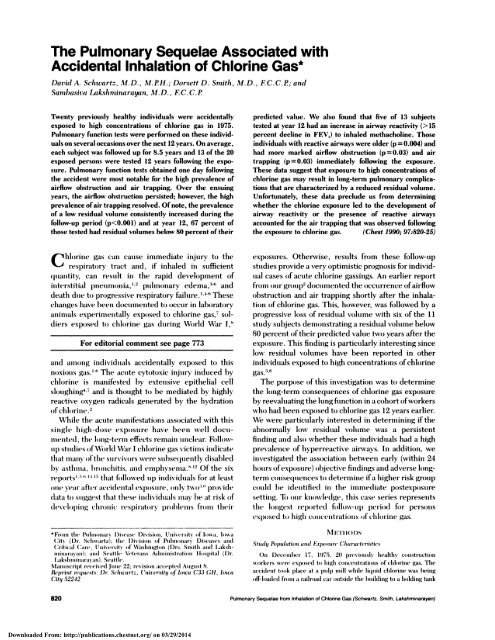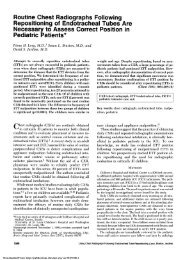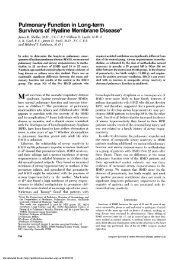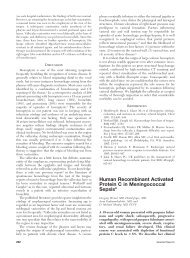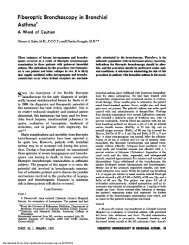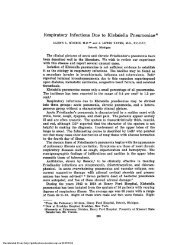The Pulmonary Sequelae Associated with Accidental Inhalation of ...
The Pulmonary Sequelae Associated with Accidental Inhalation of ...
The Pulmonary Sequelae Associated with Accidental Inhalation of ...
Create successful ePaper yourself
Turn your PDF publications into a flip-book with our unique Google optimized e-Paper software.
<strong>The</strong> <strong>Pulmonary</strong> <strong>Sequelae</strong> <strong>Associated</strong> <strong>with</strong><br />
<strong>Accidental</strong> <strong>Inhalation</strong> <strong>of</strong> Chlorine Gas*<br />
David A. Schwartz, M.D. , MPH.; Dorsett D. Smith, M.D. , F.C.C.; and<br />
Sambasiva Liikslinzinarayan, Al. D. , F. C. C. P<br />
Twenty previously healthy individuals were accidentally<br />
exposed to high concentrations <strong>of</strong> chlorine gas in 1975.<br />
<strong>Pulmonary</strong> function tests were performed on these individuals<br />
on several occasions over the next 12 years. On average,<br />
each subject was followed up for 8.5 years and 13 <strong>of</strong> the 20<br />
exposed persons were tested 12 years following the exposure.<br />
<strong>Pulmonary</strong> function tests obtained one day following<br />
the accident were most notable for the high prevalence <strong>of</strong><br />
airflow obstruction and air trapping. Over the ensuing<br />
years, the airflow obstruction persisted; however, the high<br />
prevalence <strong>of</strong>air trapping resolved. Ofnote, the prevalence<br />
<strong>of</strong> a low residual volume consistently increased during the<br />
follow-up period (p15<br />
percent decline in FEy) to inhaled methacholine. Those<br />
individuals <strong>with</strong> reactive airways were older (p 0.004) and<br />
had more marked airflow obstruction (p 0.03) and air<br />
trapping (p = 0.03) immediately following the exposure.<br />
<strong>The</strong>se data suggest that exposure to high concentrations <strong>of</strong><br />
chlorine gas may result in long-term pulmonary complications<br />
that are characterized by a reduced residual volume.<br />
Unfortunately, these data preclude us from determining<br />
whether the chlorine exposure led to the development <strong>of</strong><br />
airway reactivity or the presence <strong>of</strong> reactive airways<br />
accounted for the air trapping that was observed following<br />
the exposure to chlorine gas. (Chest 1990; 97:820-25)<br />
C hlorine gas can cause immediate injury to) the<br />
re5)iratory tract and, if inhaled in sufficient<br />
quantity, can result in the rapid development <strong>of</strong><br />
interstitial 1)neumonia, ‘ .2 ptmhnonary edema,3#{176}’ and<br />
death due to) progressive respiratory failure.I,16 <strong>The</strong>se<br />
changes have been documented to) occur in laboratory<br />
animals experimentally exposed to chlorine gas,7 soldiers<br />
exposed to chlorine gas during World War I,<br />
For editorial comment see page 773<br />
and among individuals accidentally exposed to this<br />
noxious gas. ‘“ <strong>The</strong> acute cytotoxic injury induced by<br />
chlorine is manifested by extensive epithelial cell<br />
sloughing” and is thought to be mediated by highly<br />
reactive oxygen radicals generated by the hydration<br />
o)f chlorine.2<br />
While the acute manifestations associated <strong>with</strong> this<br />
single high-dose exposure have been well documnented,<br />
the long-tern effects reniain unclear. Follow-<br />
(11) studies o)fVok)rld \Var I chlorine gas victims indicate<br />
that tiian’ o)fthe survivo)rs were subse(luentlv disabled<br />
l’ asthnia, bronchitis, amid emnphvsemna.5.m2 Of the six<br />
rt’ports’#{176}#{176}’’’’’t1iat filloved tip individuals for at least<br />
one ‘ear after aCCi(lemital eXpO)stlre, 0)111%’t\x0)#{176}t’ 1)mo)\’ide<br />
(lata to) stiggest that these in(lividuals may be at risk <strong>of</strong><br />
(leveloping ChrO)IliC m’t’s)iI’atory 1)r0)l)lt’I1s fromn their<br />
exposures. Otherwise, results from these follow-up<br />
studies provide a very optimistic prognosis for individual<br />
cases <strong>of</strong> acute chlorine gassings. An earlier report<br />
from our group2 documented the occurrence <strong>of</strong> airflow<br />
obstruction and air trapping shortly after the inhalation<br />
<strong>of</strong> chlorine gas. This, however, was followed by a<br />
pro)gressive loss <strong>of</strong> residual volume <strong>with</strong> six <strong>of</strong> the 11<br />
study subjects demonstrating a residual volume below<br />
80 percent O)f their predicted value two years after the<br />
exposure. This finding is particularly interesting since<br />
low residual volumes have been reported in other<br />
individuals exposed to high concentrations <strong>of</strong> chlorine<br />
gas.3’6<br />
<strong>The</strong> purpose o)f this investigation was to determine<br />
the long-term consequences <strong>of</strong> chlorine gas exposure<br />
by reevaluating the lung function in a cohort <strong>of</strong> workers<br />
who had l)een exposed to chlorine gas 12 years earlier.<br />
We were particularly interested in determining if the<br />
abnormally low residual volume was a persistent<br />
finding and also whether these individuals had a high<br />
prevalemice O)f hyperreactive airxvays. In addition, we<br />
investigated the association l)etWeen early (<strong>with</strong>in 24<br />
hours <strong>of</strong>exposure) o)I)jective findings and adverse longterm<br />
consequences to) determine ifa higher risk group<br />
Cotil(l be ideuitified i n the i mnn)e(liate postexposure<br />
setting. Vt) our knowledge, this case series represents<br />
the longest reported folhw-up l)erio(l for persons<br />
exposed to) high concentrations <strong>of</strong> chlorine gas.<br />
*Fro)mll tho’ PImlm110)narv 1)isvaso I)ivision, University <strong>of</strong> loeva, Iosva<br />
( itv (I)r. So’iosvartz); tiso’ l)ivisiomo <strong>of</strong> Pulmiomoarv Diseases amid<br />
( ritio’al ( ,oi’(’. t1m,iersit o<strong>of</strong> \Lsilimogtoon (I)rs. Sm1litil an(I Lakshmuimooro’amo);<br />
aml(1 Seattle Veteramis Adnlinistratioml I Ioosl)itdl (I)m’.<br />
I.aksiumuinaravan). Seattle.<br />
Nlamlmls(-ril)t roceiveol Jmmno 22; ro’visio)mI d(l’t’1)t0ol Auguist S.<br />
Reprint re(ju(’sts: !)r. Selmmcartz, tnirersiti, <strong>of</strong> lomt’a C3.3 GH, Iomva<br />
(:it,1 .52242<br />
ME’I’I lOI)S<br />
Stmulq Population 070(1 I’Xp0507’(’ Cloaraeteri.s’ties<br />
On Decemuher 17, 197.5, 20 pres’ioumsly healthy comistrimction<br />
woorkers were exposed to) high c(oncemltratio)ns o)f chlorine gas. <strong>The</strong><br />
accident toook I)iace at a I)m011) fllill Wilile liojuid chlorine was being<br />
o<strong>of</strong>f-loaoledf’ronld railroad car otmtside the i)mmilding to a hoddimig tank<br />
820 <strong>Pulmonary</strong> <strong>Sequelae</strong> from <strong>Inhalation</strong> <strong>of</strong> Chlorine Gas (Schwartz, Smith, Lakshmiroara yen)<br />
Downloaded From: http://publications.chestnet.org/ on 03/29/2014
Table 1 -Clinical Characteristics* <strong>of</strong>Exposed Workers at<br />
the Time <strong>of</strong>Exposure by Length <strong>of</strong> Follow-up<br />
All Workers<br />
Follow-up Time, yr<br />
(N=20) 12(N=13)
Tinie<br />
After<br />
Table 3-Lung Volumes and Diffusing Capacity*<br />
(Mean ± SD) During 12-Year Period <strong>of</strong> Observation<br />
Expoosure N TLC RV FRC DCO)<br />
Day 1 19 108.2±19.6 141.6±45.0 108.5±19.5 . .<br />
I)ay 10 20 110.3±15.4 124.1±30.9 106.9±25.3 . .<br />
Day 40 17 108.7 ± 16.6 108. 1 ± 25.8 99.4 ± 20.2 94.6 ± 18.3<br />
1 yr 15 102.7±14.8 98.9±28.6 90.3±20.6 94.5±26.1<br />
2vr 13 99.9±15.3 88.2±24.4 90.8±18.0 90.4±15.5<br />
9 yr 6 101.8± 19.0 83.9±37.2 100.8±31.7 110.8± 16.9<br />
12r 13 102.5±12.9 82.3±39.2 93.9±23.1 105.6±23.0<br />
pvaluet 0.48 0.0001 0.12 0.82<br />
* Percent predicted.<br />
tCalculated tosing amialysis o<strong>of</strong> variance.<br />
With the exception <strong>of</strong> an initially high mean residual<br />
vo)lume that progressively diminishes throughout the<br />
years <strong>of</strong> follow-up, few changes are apparent in either<br />
the spirometry measures (Table 2) or lung volumes<br />
(Table 3). This relationship is also depicted in Figure<br />
I where the prevalence <strong>of</strong> airflow obstruction (FEy3!<br />
vC ratio 120<br />
percent predicted) diminishes from 61 percent to 8<br />
percent and the prevalence <strong>of</strong> study subjects <strong>with</strong> a<br />
low residual volume (
100<br />
w z<br />
1<br />
Lu<br />
(1)<br />
80<br />
><br />
LU<br />
LI.<br />
60<br />
Baseline 5 25 50<br />
CUMULATIVE DOSE (Breath Units)<br />
FIo:oIOF: 2. Percentage <strong>of</strong> Loll fromml baseline FE\’<br />
0 )i)so-rved soit Io tiot- didn’t-s iateol mnoiihe’l to uline<br />
airway challenge iii tie’ 13 o.xisoseol u-orkers<br />
1 50 tested 12 vo’.ors tI’ter oxposuro to (-illo)rimoo’ gos.<br />
One in’eatio ommoitis coma1 too0)3W illll;llatio)IIod 1<br />
mug/mill <strong>of</strong> mnttilao’holino<br />
those <strong>with</strong> po)siti\’e airway responses to) methacholine<br />
(N = 5) tended to) be older (p 0.004) and demonstrated<br />
airflow obstructio)n (p = 0.03) <strong>with</strong> more air<br />
trapping (p = 0.03) on standard pulmonary function<br />
tests obtained <strong>with</strong>in 24 hours <strong>of</strong> the exposure (Table<br />
5). After controlling for age, we found that the degree<br />
<strong>of</strong> air trapping on initial pulmonary function testing<br />
was directly associated <strong>with</strong> airway reactivity only<br />
among those who) were at least 35 years <strong>of</strong> age at the<br />
time <strong>of</strong> the exposure to chlorine gas (data not shown).<br />
<strong>The</strong> limited number <strong>of</strong> sUl)jects precluded a formal<br />
multivariate<br />
analysis.<br />
D1s1sS1oN<br />
Our findings suggest that short-term exposure to)<br />
high concentrations <strong>of</strong> chlorine gas may lead to longterm<br />
respiratory complications. We found that accidental<br />
exposure to chlorine gas acutely maiuifests as<br />
air trap)i11g. However, during the 12-year period <strong>of</strong><br />
observatio)n, we noted a progressive decline in residual<br />
volume <strong>with</strong> 67 percent <strong>of</strong> those tested at year 12<br />
having a residual volume below 80 percent <strong>of</strong> their<br />
predicted value. This finding should be contrasted<br />
<strong>with</strong> an expected increase in residual volume <strong>of</strong> 20<br />
mi/yr given the age and height characteristics <strong>of</strong> our<br />
study population. ‘ In addition, we found that five <strong>of</strong><br />
13 subjects tested at year 12 had an increased airway<br />
reactivity to) inhaled methacholine and that the risk <strong>of</strong><br />
having reactive airways was directly related to) the<br />
degree o)fairflow obstruction and air trapping that ‘as<br />
observed immediately following the exposure.<br />
<strong>The</strong> loss <strong>of</strong> residual volume iii our chlorine-exposed<br />
cohort represents an important o)hservatio)n that helps<br />
us to) piece together the findings from the other studies<br />
that have addressed this type <strong>of</strong> ouma6mi.mS In<br />
Table 6, we review the six other case series that have<br />
evaluated the short- and long-term (at least one year<br />
<strong>of</strong> follow-up) pulmonary changes in individuals acci-<br />
dentally’ eXI)osed to high co)ncent rationis <strong>of</strong> chlori no’<br />
gas. Of the four reports that actually prestiit ptilinonar<br />
function results,l,10I5 studies56 report lower<br />
than expected values for residual volume at tho’ emid<br />
<strong>of</strong> the follow-up period. However, the most comprehensive<br />
sttidy’5 to) date has found minimal changes in<br />
residual \‘O)ltlfllC ( - 1 mllvr) during the six-ear folloxx’-<br />
up peno)d. <strong>The</strong> inconsistency <strong>of</strong>our findings <strong>with</strong> this<br />
pre’is repo)rt is difficult to) explain l)LIt mnay reflect<br />
the different exposure conditio )ns <strong>of</strong> on r respective<br />
cohoorts. 1mm the only study2 that systemnatically revie\Ved<br />
1)atients <strong>with</strong> isolated redtictioiis in I’csi(lual<br />
volunie, toxic iruhalatiomus (ho’drocarbomus, amnmiio)ilia,<br />
Table 4-Relationship Between Residual Volume at Year 12<br />
and Clinical Charaiteristics* Within 24 hours <strong>of</strong> Exposure<br />
to Chlorine Gas<br />
o-ategorio.- variables are exI)resseol as tue frt’oiue’no.- (1o’rco-mot <strong>of</strong> total<br />
smobjeets).<br />
i10Si(iu1al\olimmoot it loam’ 12<br />
Table 5-Relationship Between Airway Response to<br />
Methacholine Challenge at Year 12 and Clinical<br />
Characteristics* Within 24 Hours <strong>of</strong>Exposure to<br />
Chlorine Gas<br />
Niethacholin e Cllallemlge<br />
Poositive<br />
Negative<br />
(N=5) (N=8) 1)dltme<br />
Ageat exposure. yr 48.7±9.6 33.7±5.5 0.004<br />
Smoking hishor; Noo. (%)<br />
Never . . . 1 (13)<br />
Ex 3 (61)) 6 (75) 0.42<br />
CLmrre’mlt 2 (40) 1 (13)<br />
Day 1 CXR, No. (%)<br />
Infiltrates . . . 3 (:38) 0.23<br />
Day 1 PFTst<br />
FEy 75.8±29.5 86.6±24.2 0.48<br />
FEV/VC ratio 59.8± 14.5 74.9±6.7 0.03<br />
V(: 96.3±21.4 96.0±22.8 0.86<br />
LIV 183.9±60.6 125.0±26.5 0.03<br />
TIA: 126.4±20.7 99.2±17.6 0.03<br />
FRC 128.3±5.6 99.9± 17.5 0.005<br />
*(‘o,,Jti,)m300mos variai)les are (.xpresso(I as tue mucan ± SI) so bile<br />
categoric variables are exl)ressed as tile freoiuencv (percent <strong>of</strong> total<br />
subjects).<br />
tPF”I’s: individual measures ni I)mmlmlloonarY function are tll expressed<br />
as a I)t’rco’mot prt-olicteol eX(’(’pt for the FEVA’C ratio.<br />
sulfur dioxide, and pesticides) were l)elieved to be<br />
responsible for 16 percent <strong>of</strong> the cases. Although the<br />
clinical significance <strong>of</strong> this physiologic abnormality<br />
remains unclear, the reduced residual volume observed<br />
in tir sul)jects is supported by other studies<br />
and may represent a characteristic feature <strong>of</strong> lung<br />
function following short-term exposure to this agent<br />
as we11 as other no)XiouS gases. 20<br />
<strong>The</strong> observed reduction in residual volume suggests<br />
that the initial injury may result in chronic stiffening<br />
<strong>of</strong> the airways. Since residual volume is determined<br />
l)y the strength <strong>of</strong> the expirato)ry muscles and the<br />
pressure-volume characteristics <strong>of</strong> the lung and chest<br />
wall, reductions in residual volume result from an<br />
increase in either muscle strength, chest wall compliance,<br />
o)r ii) the elastic recoil <strong>of</strong> the lung. In healthy<br />
persons older than 35 years <strong>of</strong> age, residual volume<br />
has been found to be largely determined by airway<br />
co)llapse.#{176}’ Presuming that chlorine gas has not affected<br />
the mechanics O)f the chest wall, two possible explanations<br />
exist for the observed reduction in residual<br />
volume. First, diffuse parenchymal injury induced by<br />
chlorine gas may result in mild roentgenographically<br />
inapparent interstitial fibrosis that could increase the<br />
elastic recoil O)f the lung. <strong>The</strong> increased elastic recoil<br />
would result in a low residual volume by its tethering<br />
effect on small airways, tending to) maintain their<br />
patency at low lung volumes while permitting a nearly<br />
normal expansion at total lung capacity. Alternatively,<br />
acute airway damage may result in mild peribronchiolar<br />
fibrosis that may stiffen the bronchioles and cause<br />
them to be more resistant to closure during exhalation.<br />
Maintaining airway patency at low lung volumes would<br />
permit continued exhalation and result in a reduced<br />
residual VO)luflle. Animal studies7 and po)stmorten)<br />
sttidies in tw’() humans#{176} suggest that the latter hypothesis<br />
is more likely: W7ithin hours <strong>of</strong>exposure to chlorine<br />
gas, patholo)gic specimens demonstrate extensive<br />
sloughing <strong>of</strong> airsvay epithelia, svhich is followed by an<br />
intense inflammatory response . Animals killed between<br />
two weeks and six months following the exposure<br />
were found to have persistent airway inflammatiO)fl<br />
<strong>with</strong> extensive bn)nchitis, bronchiectasis, and<br />
bronchiolitis n Thus, in some cases, acute<br />
extensive airway injury is followed by persistent airway<br />
inflammation and fibrosis. <strong>The</strong> peribronchial fibrosis<br />
comld account for the persistent decline in residual<br />
volume that sve observed among our expo)sed construetiO)I1<br />
workers. However, <strong>with</strong>out histologic confirmation,<br />
the mechanism(s) accounting for this finding<br />
remains speculative.<br />
Although the prevalence <strong>of</strong> positive airway re-<br />
SOn5C5 to) methacholine in our exposed cohort is<br />
relatively high (38 percent <strong>of</strong> subjects tested), given<br />
the high prevalence <strong>of</strong> smoking in this cohort, it is<br />
Table 6-Reports <strong>of</strong><strong>Accidental</strong> Exposure to Chlorine Gas in Which the Subjects Were Followed upfor at Least One Year<br />
Type<br />
<strong>of</strong><br />
Noo. ool Subjects<br />
<br />
- Folloow-up<br />
Puinuomiary Fimmlction Tests<br />
. ‘ .<br />
Accident, Referemce Exposed Foollonved-up Time, yr Initial End <strong>of</strong> Fodioeo’-up<br />
New Yoork (:it sui)wa\;’ 2()8 3.3 1.3 Not obtailled Not ooiotaimied<br />
Loongshoretnan, 156 1 1 1.7 , FRC Noormnal<br />
Lo)ngshooreman, 156 59 1 .6-2.9 Not oohtained Airway resistance<br />
FEy amid IRV<br />
Freight traimi,” 1(X) 12 7.0 Not o)htaineol J RV (5/7 tested)<br />
FEy, (5/10 tested)<br />
Filtration plant,#{176} 35 18 1.2 RV (7/18)<br />
1 RV (3/12)<br />
I FEy (5/18)<br />
FE!I (3/12)<br />
fecompatioonal,’’ 56 56 5.0 Noot rep.tortoi Noot reported<br />
Freight traim,#{176} 145 61) 6.0 Nornlal spiroometr<br />
and lumig volimnies<br />
Normal PF’Ts <strong>with</strong><br />
boss o<strong>of</strong> 1 nol.5’r in RV<br />
824 <strong>Pulmonary</strong> <strong>Sequelae</strong> from <strong>Inhalation</strong> <strong>of</strong> Chlorine Gas (Schwartz, Smith, Lakshminarayan)<br />
Downloaded From: http://publications.chestnet.org/ on 03/29/2014
consistent <strong>with</strong> expected 27 However, after controlling<br />
for age, we found that the degree <strong>of</strong> air<br />
trapping on initial (<strong>with</strong>in 24 hours <strong>of</strong> the exposure)<br />
pulmonary function testing was directly associated<br />
<strong>with</strong> airway hyperreactivity 12 years following the<br />
exposure. <strong>The</strong>se findings suggest that the early development<br />
<strong>of</strong>air trapping following chlorine gas exposure<br />
may be predictive <strong>of</strong> those who go on to develop<br />
bronchial hyperreactivity. Alternatively, those vorkers<br />
who had more air trapping 0!) initial lung function<br />
testing might also have underlying airflow obstruction<br />
prior to the exposure and thus, they may be more<br />
likely to) respond to methacholine 12 years after the<br />
exposure. Unfortunately, these data preclude us from<br />
determining whether the chlorine exposure led to) the<br />
development <strong>of</strong>hyperreactive airways or the presence<br />
<strong>of</strong>hyperreactive airways accounted for the air trapping<br />
that was observed immediately following the exposure<br />
to chlorine gas.<br />
In the absence <strong>of</strong> preexposure pulmonary function<br />
tests and individual measures <strong>of</strong> exposure to chlorine<br />
gas, it is difficult to l)e certain that the changes we<br />
observed were, in fact, caused by chlorine gas. However,<br />
given the initial symptomatolog; pul n)onary<br />
function al)normalities, and chest roentgenographic<br />
findings, it is clear that these workers developed acute<br />
respirato)ry problems associated <strong>with</strong> their exposure<br />
to this no)xious gas. <strong>The</strong> diminished residual volume<br />
observed years fillowing the exposure is unusual, and<br />
given the nature <strong>of</strong> the injury, it appears to be related<br />
to) the exposure. In the aI)sence <strong>of</strong> associated respiratory<br />
symptoms, the exact clinical significance <strong>of</strong> this<br />
physiologic abnormality remains unclear. <strong>The</strong> association<br />
between the early development <strong>of</strong> air trapping<br />
following the exposure and reactive airways may prove<br />
to) be related to chlorine gas exposure; however, the<br />
temporal sequence <strong>of</strong>these events needs to be further<br />
clarified.<br />
REFERENCES<br />
1 Kaufman J, Btmrkoons D. Clinical, roentgemlooloogic, and physioloogic<br />
effects <strong>of</strong> acute chlorine exposure. Arcil Environ ilealth 1971;<br />
23:29-34<br />
2 Charan NB, Lakshminaravan 5, Meyers CC, Smith DD. Effects<br />
<strong>of</strong> accidental chlorine inhaiatiom in pulnloonary functioon. Vest J<br />
Med 1985; 143:333-36<br />
3 Kowitz TA, Reba RC, Parker RT, Spicer WS. Effects o<strong>of</strong> chlorine<br />
gas upton respiratoory functioon. Arch Emoviron health 1967;<br />
14:545-58<br />
4 Adelsorn L, Kaufman J. Fatal chlorine pooisoning: report <strong>of</strong> twoo<br />
cases <strong>with</strong> clinicopathooloogic coorrelatioon. Am J Clin Pathooi 1971;<br />
56:430-42<br />
5 Joovmier RE, I)urel E(;. Acciolo-motal li(lui(i chlorimie spill in d rural<br />
conlmunit\ J Occump Med 1962; 4:152-54<br />
6 Weill ii, (;eo)rge R, Schwarz NI, Ziskind NI. Late evaluationi <strong>of</strong><br />
pulmonary functioon after acmmte exposumre to) chloorine gas. Ammo<br />
Rev Respir Dis 1969; 99:374-79<br />
7 \Vinternits. Nl(:. Pathologv <strong>of</strong> war gas pooisonimig. New ilmven,<br />
Conn: Yale University Press; 1920.<br />
8 (;ilchnst IlL, Mats PB. <strong>The</strong> residual effects <strong>of</strong> warfare gases:<br />
tile use o<strong>of</strong> cilloorimle gas, <strong>with</strong> report <strong>of</strong> cases. Nied Bull VoL<br />
Adnlin 1933; 9:229-68<br />
9 Sandall TE. <strong>The</strong> later effects o<strong>of</strong> gas poisooning. Lancet 1922;<br />
2:857-59<br />
10 Bergh<strong>of</strong>f RS . <strong>The</strong> niore comumnon gases: tileir effect omi the<br />
respiratory tract. Arch Intern Med 1919; 24:678-84<br />
1 1 Ahbott ‘N . <strong>The</strong> incidemue <strong>of</strong> pulmonary disease folloaving<br />
(-xpoosure too vesicant amlol asphyxiating gases. Br Meol J 193.3;<br />
2:862-65<br />
12 Hankimls JL, Klotz \VC. Permmoinent I)lmlnlonar effects <strong>of</strong> gas in<br />
warfare. Aol Rev Tuioerc 1922; 6:57 1-74<br />
13 Barret L, Famire J. Cilloorille pooisonin Iletterl. L.anct-t 1984;<br />
1:561-62<br />
14 Chasis ii, Z.aI)i) ,JA. Bannomi Jil, Vhittemlix-rger JL, ilo-Im J,<br />
I)ohemlv JJ, et al. Cillowine acc.’iolemlt im Broooklvm. Occmmp Nleoi<br />
1947; 4:152-76<br />
15 Jones RN . llmmghes J, Clinolmever ii. \V-ill II. Lumug fmmnctiomu<br />
after acumto o-hlorimie’ exposure. Am Rev Respir Dis 1986; 134:<br />
1190-95<br />
16 ATS Statenio’mot. Snowbird workshoop omo staml(lar(lizatiomo o<strong>of</strong> spiro)nletrs<br />
Am Rev Respir I)is 1979; 119:8.31-38<br />
17 olorris JF, Kooski A, Joiinson LC. Spiromnetric staml(lards for<br />
healthy mlo)nsmnoking adults. Am Rev Respir Dis 197!; 10.3:57-67<br />
18 (;oldmaml iii , Becklake NIR. Rospiratorv fimmictiomi tests: noormal<br />
values at mileolian altitudes and the predictioon o<strong>of</strong> noornial results.<br />
Anl Rev Tmmioerc 1959; 79:457-67<br />
19 \on (;anso’ \\‘F, Ferris BC, Cotes JE. Cigarette snooking and<br />
l)t1lmllmlarY difl’usiiug capacity (tramisfer factor). Aol Rev Respir<br />
Dis 1972; 11)5:30-4 1<br />
20 Chathamu NI, Blo-ecker ER, Normal P. Smith PL, Niasoomo P A<br />
screemling test for airsvavs reactivity: .111 alobreviateol muetilacia)-<br />
line inhalationo challenge. Chest 1982; 82:1.5-8<br />
21 Coltom T. Statistics in medicine. Bostoml, Mass: Little Brown &<br />
(:oo; 1974<br />
22 Docker D\’S \Vare Jil, Ferris BC, Clicksherg DS, Fav ME,<br />
Spiro A, et al. I)istriinmtioon o<strong>of</strong> forced expiratoory vo)lumne in oma<br />
secoml(l amld forced vital capacity in health); white, adult nevem<br />
smookers in six U.S. cities. Am Rev Respir Dis 198.5; 131:51 1-21)<br />
23 Bumrroows B, I.eboowitz MD, Camilli AE, Knudson RJ. i.omgitudinal<br />
cilanges iml forced expiratorv vo)lunle in oone secootul ill<br />
adomlts. Am Rev Respir Dis 1986; 133:974-81)<br />
24 Owens M\’u Kimiasewit-s CT, Andersoon WM . Clinical significamce<br />
o<strong>of</strong> all isO)lated reductioon in residual voolionie. An Rev<br />
Respir Dis 1987; 136:1377-80<br />
25 Nlurrav JF. <strong>The</strong> no)rtnal lummig. Philadelphia, Pa: \VB Saumnders<br />
Go; 1986<br />
26 Leith DE, Mead J. Mechanisms determining residual volume<br />
<strong>of</strong>tile lungs in mooormnal sui)jects. J AppI Physiool 1967; 2.3:221-27<br />
27 Sparrow D, OComlmlor C, Colton T, Barry CL, Weiss ST. <strong>The</strong><br />
relatioonship o<strong>of</strong> mlOmlspeeific bronchial responsivemless too the<br />
ooecurrence <strong>of</strong> respiratory sVnlpto)fllS amld do-creased levels <strong>of</strong><br />
pulmoonary fmoi.ction. Am Rev Respir Dis 1987; 13.5: 125.5-61)<br />
CHEST I 97 I 4 I APRIL 1990 825<br />
Downloaded From: http://publications.chestnet.org/ on 03/29/2014


